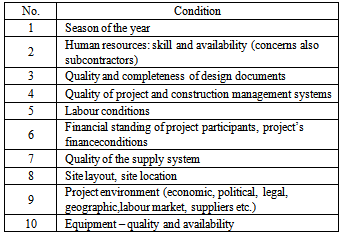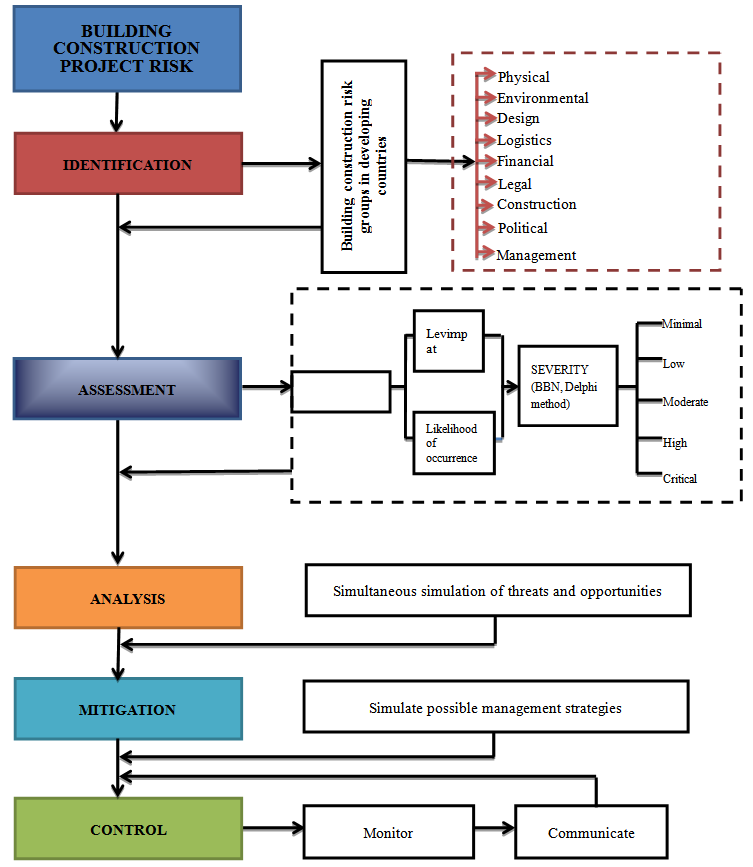-
Paper Information
- Paper Submission
-
Journal Information
- About This Journal
- Editorial Board
- Current Issue
- Archive
- Author Guidelines
- Contact Us
International Journal of Construction Engineering and Management
p-ISSN: 2326-1080 e-ISSN: 2326-1102
2013; 2(5): 143-154
doi:10.5923/j.ijcem.20130205.02
Risk Assessment Framework for Building Construction Projects’ in Developing Countries
O. O. Odimabo, C. F. Oduoza
Faculty of Science and Engineering, University of Wolverhampton, WV1 1SB, United Kingdom
Correspondence to: O. O. Odimabo, Faculty of Science and Engineering, University of Wolverhampton, WV1 1SB, United Kingdom.
| Email: |  |
Copyright © 2012 Scientific & Academic Publishing. All Rights Reserved.
Economic growth and socio-economic development are particularly important for developing countries; and the construction industry plays a central role in driving both of these. The general situation observed currently in building construction in a developing country such as Nigeria is that the output of a construction company is usually characterisedby poor quality work, cost and time overruns. These characteristics originate because a number of risk factors have not been properly taken into consideration in the project planning and implementation stage. Therefore, a focus on risk management is necessary to improve the current project’s poor performance. This paper aims to establish an exclusive and comprehensible risk management framework which will improve the performance of building construction projects in developing countries. The improved performance will be in the form of achieving successful project delivery within the time frame, minimising cost overruns and optimising project quality.
Keywords: Building Construction, Developing Countries, Risk Assessment, Risk Management
Cite this paper: O. O. Odimabo, C. F. Oduoza, Risk Assessment Framework for Building Construction Projects’ in Developing Countries, International Journal of Construction Engineering and Management , Vol. 2 No. 5, 2013, pp. 143-154. doi: 10.5923/j.ijcem.20130205.02.
Article Outline
1. Introduction
- Buildings have been considered as one of the most valuable assets of a nation to provide people with shelter and facilities for work and leisure[1]. Building construction projects have been identified as one of the most dynamic, risky and complex endeavours[2, 3]. An overview of the traditional construction process can be explained in four simple stages: conceptual design, construction, operation and maintenance. However, the passage from one stage to another is not all “smooth-sailing”, but fraught with problems[4]. The cost of risk is a concept many construction companies have never thought about despite the fact that it is one of the largest expense items[5]. Risk can be managed, minimized, shared, transferred or accepted. It cannot be ignored[6]. Risk management helps the key project participants - client, contractor or developer, consultant, and supplier - to meet their commitments and minimize negative impacts on construction project performance in relation to cost, time and quality objectives[7].The general situation observed currently in building construction in a developing country such as Nigeria is that the output of a construction enterprise is usually characterisedby poor quality work, cost and time overruns. These characteristics originate because a number of risk factors have not been properly taken into consideration in the project planning and implementation stage.To address this challenge, risk management has become an important part of the decision-making process in construction industry - as it determines the success or failure of construction projects[8].This paper is aimed at developing a comprehensive and continuous risk assessment framework suitable for the improvement and management of building construction project success through a systematic and integrated process approach of the key risk factors affecting building construction project delivery. The objectives are: to identify the major risk factors that have significant impact on building project performance in developing countries; to develop a risk management framework pattern involving identification, assessment, analysis, mitigation and control of riskon a continuous and practical basis in order to achieve improved performance and a successful project delivery within a given time frame, while minimising cost overruns and optimising project quality.This paper will review the existing literature on risk management in construction projects in developing countries. The work presented in this paper will highlight possible research in this area, find out their drawbacks and limitations, and evaluate the potential for further research. A comprehensive review of risk management literature published in the project management and construction management domains will be undertaken.
2. Literature Review
2.1. Construction Project Risk
- Risk is a complex phenomenon that has physical, monetary, cultural and social dimension[9]. Risk is the probability of occurrence of uncertain, unpredictable and even undesirable events that would change the prospects for the profitability on a given investment[10]. Managing risk is to minimize, control and share risk and not just pass them off unto another party[10]. Project in controlled environment describes risk as the chance of exposure to the adverse consequences of future events[11]. Consequently, Smith et al[12] states that risk exists when a decision is expressed in terms of a range of possible outcomes and when known probabilities can be attached to the outcomes. A construction risk is a variable in the process of construction, whose occurrence results in uncertainty as to the final cost, duration and/or the quality of the project[13].However, the environment in which decision-making takes place can be described in three methods, which include certainty, risk and uncertainty[8]. Certainty exist only when one can specify exactly what will happen during the period of time covered by the decision and conform to the specific requirements of certainty[8]. However, this does not happen in the construction industry. Making a distinction between uncertainty and risk is necessary in order to be able to explain the influence of these on project performance[14]. Uncertainty is defined as a context for risks as events having a negative impact on the project’s outcomes, or opportunities, as an event that have beneficial impact on project performance[14]. This definition stresses dual nature of uncertainty in potentially having both positive and negative influence on the project’s outcomes. Uncertainty can arise from sources both internal and external to the project. Consequently, Perminove et al.[14] describes uncertainty, as an event or a situation, which was not expected to happen, regardless of whether it could have been possible to consider it in advance. Hence, uncertainty is when the established facts are questioned and thereby the basis for calculating risks (known negative events) or opportunities (known positive events) is questioned. Thus, Bryde and Volm[15], provides a holistic view of project risk as shown in figure 1. using Hargitay and Yu[16] spectrum of uncertainty which goes from “total uncertainty” to “certainty”. Where “total uncertainty” being where the outcome is notknown and alternative outcomes cannot be identified; “partial uncertainty” where alternative outcomes can beidentified but probabilities cannot be estimated; “risks” when probabilities can be estimated; and ‘certainty’when the outcome is known.
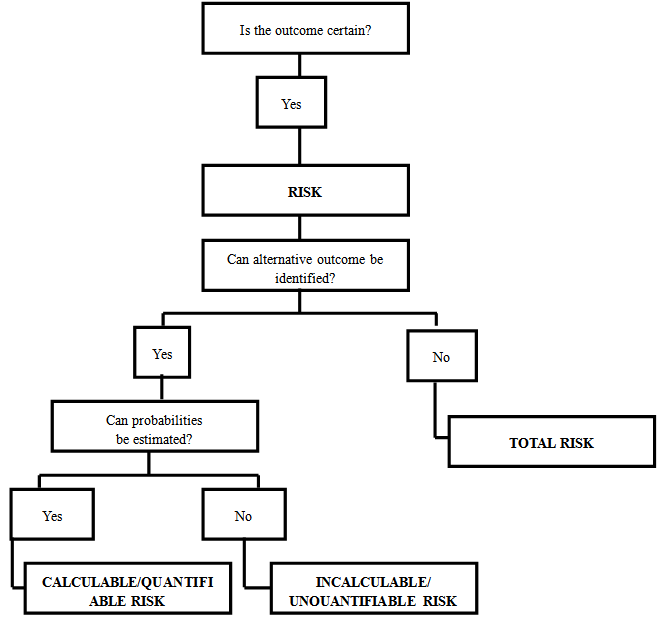 | Figure 1. A holistic view of project risk[15] |
2.2. Risk Management Process for Building Construction Projects
- Building projects in developing countries have constantly faced great difficulty in controlling time and cost overruns. An example of poor construction performance can be found in the Nigeria construction industry. The research conducted by Okuwoga[19], shows that the performance of the building construction industry in Nigeria has consistently been a source of concern to both public and private sector clients. The study conducted by Okuwoga[19] on some 42 building projects executed by the federal government of Nigeria through the federal housing authority, Ogun state housing corporation, Oyo state ministry of works and housing, and Lagos state property development corporation (LSDPC) concludes that the performance of building projects in terms of cost and time parameters is least satisfactory. Consequently, Oyewobi et al[20] pointed out that cost and time overruns have become a cankerworm within the Nigeria construction industry today as well as lack of good quality work of its end product which do not provide many of the clients’ value for money. Construction projects in Nigeria are known for overshooting their initial cost budget, which invariably means it is out of initial time schedule[21].Construction projects are dynamic, as reported by Bobick[22] and are characterized by many unique factors but are not limited to work team rotations, exposure to weather conditions and changes in topography, topology and working conditions throughout the project life cycle[23]. Therefore, in order to improve the chance of success and reduce these potential risks associated with these building construction projects, risk management is an important part of the decision making process for a construction enterprise.Risk management is a management disciplinewhose goal is to protect the asset, reputation, and profits an organization by reducing the possible losses or damages before they occur[24]. Risk management is one of the nine knowledge areas (i.e., integration management, scope management, time management, cost management, quality management, human resource management, communications management, risk management, and procurement management) propagated by the Project Management Institute[25]. Zou et al[26] describe risk management in the construction project management context as a systematic way of identifying, analysing and dealing with risk as associated with a project with an aim to achieve the project objectives while Williams[27] describe project risk management as an integrated process which includes activities to identify project uncertainty, estimate their impact, analyse their interactions, control them in the execution stage, and even provide feedback to the maintenance of collective knowledge asset.Recent developments in the field of risk management have enabled better understanding of the overall risk management process[28, 29,30, 31]. Risk management is an activity process which defines the sources of uncertainty (risk identification), estimates the consequences of uncertain events/conditions (risk analysis) and generates response strategies[32]. Figure 2. shows the cyclical risk management process, which is carried out independently for each phase of the construction project.
 | Figure 2. Cyclical risk management process[33] |
- Risk management in construction is a tedious task as the objective functions tend to change during the project life cycle[34]. A properly implemented risk management process will enhance the successful completion of building construction projects and thereby make the projects more profitable. When risk management is applied chaotically and arbitrarily, it can jeopardize the realization of the project as most of the risks are very dynamic all the way throughout the project lifecycle.
2.3. Risk Classification
- Different sources of construction risk have being identified in previous studies. Many approaches have been suggested in the literature for classifying risk. El-Sayegh[35] presented a list of several factors in the terms of Owners, design, contractors, sub-contractors, suppliers, political, social and cultural, economic, natural and others. Nieto-Morote and Ruz-Vila[36] suggested four ways of classifying risk: project management risk, Engineering risk, execution risks and suppliers risk. Kuo and Lu[37] group risk into five sub-sets: Engineering design, Construction management; construction safety-related, natural hazards and socio and economic while Dikmen et al[34] categorised risk into eight ways: Technical risk, managerial risk, resource risk, productivity risk, design risk, payment risk, client risk and subcontractors’ risk.Different approaches can be used to classify the risks associated with construction projects and the rationale for choosing a method must serve the purpose of the research. In this paper, risk will be grouped usingEnshassi and Mosa[38] method who has classified typical risk groupsthat are peculiar to developing countries. Table 1 shows the various groups and the associated risk categorised.
|
2.4. Risk Assessment in Building Construction Projects
- Risk assessment is a critical procedure for decision-making and projecting success[27]. Azari et al.[39] reported that its main purpose is to estimate risk by identifying the undesired events, the likelihood of occurrence of the unwanted event, and the consequence of such event. This involves measures, either conducted quantitatively or qualitatively, to estimate the significance level of the individual risk factors to the project, so as to estimate the risk to project success[39].Practically, different techniques are used to carry out risk assessment[40]. The result obtained will serve as inputs for the purpose of optimum decision. Accordingly, with a better quantification measuring result, managers can recognize which risks are more important and then deploy more resources on it to eliminate or mitigate the expected consequences[39]. According to William[27], the identification and assessment of project risk are the critical procedures for projecting success, and they usually become the essential factors in the decision making process. Risk assessment or as many researchers call it risk analysis can offer an understanding to the detailed sources of project risk and assist construction industries to develop targeted helpful action.The approaches that have being frequently used in carrying out construction project risk assessment include; Probability analysis such as decision tree analysis, sensitivity analysis, Monte Carlo simulation techniques; Interval analysis estimates plausible ranges of results based on ranges for the input variables; Fuzzy set analysis is used to solve uncertainty problems, especially when probability information is limited and when boundaries of variables are not obvious[37].
2.5. Risk Assessment Past Reviews on Construction Projects
- Risk assessment is considered to be the most useful part of the risk management process[12].Traditionally, thefocus has been on quantitative risk analysis[41] despite the difficulties encountered in obtainingobjective probabilities in the construction industry, where projects are very often one-off enterprises[42]. As a result, project managers are obliged to rely onsubjective probabilities[43]. Therefore, as a probabilistic approach cannot be utilized to quantify risks, individual knowledge,experience, intuitive judgment and rules of thumb should be structured to facilitate risk assessment[34].For example, pioneering its application in construction, Mustafa and Al-Bahar[44] adopted the Analytic Hierarchy Process (AHP) to assess construction project risk. They applied the concept of value and weight to assess risk probability and impact. This study also evaluates the suitability of using AHP to assess construction project risk, describing its limitations for such applications.Kangari[2] discusses the attitude of large U.S construction firms toward risk and determines how contractors conduct construction risk management based on surveys from top U.S contractors.Kartam and Kartam[10]reportwas based on questionnaire survey on Kuwaiti contractors on the perspective of construction risk, and the effective actions taken for the management of such risks, particularly those of time and finances. The study focused on the assessment, allocation and management of construction risks. The paper presented two types of risk management methods: preventive, which are effective at the early stages of the project life, and mitigated, which are remedial actions aimed at risk minimization during construction.Baccarini and Archer[45] present a methodology, adopted by the Department of Contract and Management Services in Western Australia, which ranks projects based on risk. The methodology utilizes the P-I model, which calculates a risk score for project cost, time or quality. Like previous models, although it considers different impacts on project objectives, it is an over-simplistic approach, averaging the likelihoods and theimpacts of a risk on project cost, time and quality then multiplying them to generate a risk score. The final project risk score being the highest of the scores. The limitations of the various ways by which construction risk had previously been dealt with is discussed by Hillson[46], who proposes assessing both threat and opportunity simultaneously within P-I models qualitatively and quantitatively. Jannadi and Almishari[47] attempt to assess risks associated with various constructions project activities, defining risk as the potential damage that may affect personnel or property. They model risk by probability, severity of impact and ‘exposure’ to all hazards of an activity and provide software to generate risk scores. However, they do not provide a methodology for aggregating risk ratings.Oztas and Okmen[48] presented a literature survey that on the issues of risk, risk management/analysis and the design-build contract system, proposing a schedule and cost risk analysis model, and to show the applicability of these models in scheduling and cost estimation of a fixed-price design–build construction project through a case study.Zou et al[26], presented an understanding of the key risks in construction projects in China and developed strategies in manage them. The risks were prioritized according to their significance of influences on typical project objectives in terms of cost, time, quality, safety and environmental sustainability, and then scrutinized from a joint perspective of project stakeholders and life cycle.KarimAzari et al[49] used the fuzzy risk assessment technique for order preference by similarity to ideal solution (TOPSIS) method to provide a rational and systematic process for developing the best model under each selection criteria. Decision criteria were obtained from the nominal group technique.Zavadskas et al[32], present risk assessment of construction projects which is based on multi-attribute decision methods. The risk evaluation attributes are selected taking into consideration the interests and goals of the stakeholders as well as factors that have influence on the construction process efficiency and real estate value. Jaskowski and Biruk[50], present a risk analysis and assessment framework in which the AHP was adopted. The proposed risk model is based on evaluating and weighting the particular project’s characteristics and expected conditions. Their method is to assist planners in determining activity duration distribution parameters according to risk level. Their approach is combined with simulation techniques, which is argued to improve project planning and evaluation of risk mitigation alternatives.Having reviewed different contributions to risk assessment in the construction sector, it is observed that the risk models highlighted may not accommodate risk associated with building construction projects in developing countries such as Nigeria where cultural and political factors mainly could influence risk management of a building construction project. Therefore, a structured and systematic model to improve risks management in building construction projects is intended to be the first step towards enhancing the risk management process for project managers and contractors working in the construction industries in developing countries.
3. Proposal for a Robust Risk Management Framework Suitable for Building Construction Industry in Developing Countries
- The study proposed a mixed approach involving a combination of both qualitative and quantitative methods for this research, to acquire data from all construction stakeholders.
3.1. Research Design, Methods and Techniques
- A systematic approach to risk management for construction projects consist of the following main stages of; risk identification, risk assessment and analysis, riskmitigation and risk monitoring[12, 51, 52, 53; 54]. Figure 3. provides a view of the first risk management framework as proposed by Smith et al.Therefore, in order to meet the research objectives, a research methodology comprising of literature review, data collection (questionnaire survey, interviews and case studies), simulation and modelling, will be adopted to develop and validate a risk management model.
 | Figure 3. Identification, assessment and analysis of construction risk, the first component of the risk management system[12] |
3.2. Research Approach
3.2.1. Literature Review
- This research starts with an extensive literature review to understand the concept of risk and risk management including an up to date review of current and previous research on risk assessment and management in the building construction sector. There was a review of the variety of risk factors faced by the construction sector in developing countries and to appreciate how they were currently managed.
3.2.2. Data Collection
- The data for the investigation will be collected via three methods. These are the questionnaire, interviews and case study.a) Questionnaire: The questionnaire will be designed based on the knowledge obtained from relevant literature reviews, interviews and discussions. The questionnaire will be designed to review comprehensively all major risks that are likely to be encountered in construction projects in developing countries. b) Interviews: The interview will be totally structured where all stakeholders in the construction sector in developing countries are involved in providing inputs to issues of concern in building construction project risk management. Interview will focus on customers, contractors, and other stakeholders and will follow format for open and closed questions.c) Case study: Case studies, which involve an empirical investigation of a particular contemporary phenomenon within its real life context using multiple sources of evidence, will be applied[55]. The case study will aim at acquiring data from a building construction project, which will be followed from start to finish (life cycle approach) to fully appreciate risks encountered and their management by project stakeholders.
3.2.3. Simulation and Modelling in a Building Construction Environment
- The application of modelling and simulation techniques in solving risk management concerns has been reported by Smith et al.[12]. Modelling and simulation may be described as the process of investigating the behaviour of a system in a simulated environment. The process may involve describing a system mathematically while taking into consideration system variables and constraints. Modelling may be computer based or mathematically expressed. Usually, mathematical modelling seeks to optimise or minimise the objective function. Optimization task in risk management often seeks to identify the course of action by either maximising returns or minimizes expenditure. However, the alternative to mathematical representation of risk management decisions is the descriptive approach, which provides insight into the project considered[12]. In this study, the Delphi method[50] and the Bayesian belief network[56] will be adopted to model risk assessment/management in building construction environments.a. Delphi method for construction building project risk assessmentThe frequency and impact of risk factors on a particular construction process depend on the project-specific, contractor-specific and location-specific conditions[50]. Table 2 lists ten construction project conditions considered to be of the greatest impact on riskand deviation in activities duration, identified on the basis of a survey among chartered engineersemployed by construction companies in Poland.
|
 | (1) |
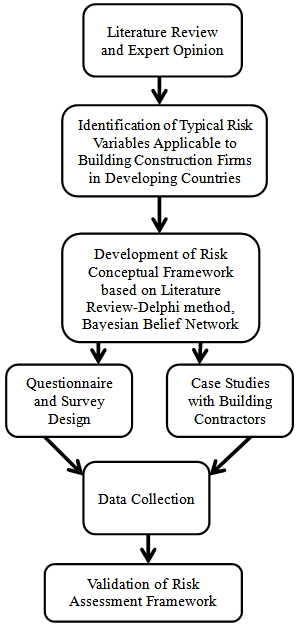 | Figure 4. Conceptual Research Design |
 | (2) |
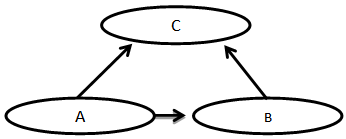 | Figure 5. A simple Bayesian belief network[56] |
 | Figure 6. Risk matrix for Bayesian belief network[61] |
4. Development of a Framework for Risk Assessment of Building Projects in Construction Firms
- Based on Seo and Choi[62] and Aloini et al[63] a research framework will be developed suitable for elaborate risk assessment of building projects especially in developing countries with a view to manage them. The study will adopt the Delphi method and Bayesian Belief Network for risk management to avoid, transfer, share, reduce, retain or ignore potential risk in building construction environment. The framework commences with identifying potential threats associated with construction building projects especially in developing countries. This will be carried out through an extensive literature review. Risk assessment will be carried out by prioritizing threats according to their risk levels. This will be done in two main steps;● Importance of the risk associated with construction building projects in developing countries- this will be evaluated based on the measurement of the likelihood of the risk events and the impact of the accident caused by the risk event. This type of risk matrix is useful for the purpose of risk assessment for categorizing the importance in term of “likelihood-impact” level.● Evaluating the severity of the risk associated with building projects in developing countries- by defining the severity of risk and selecting appropriate, effective aggregation system, the risk level for each identified risk variable will be expressed syntheticallyRisk analysis- This will provide an input to the risk evaluation for final quantification and formulation of the best response strategy. Typical inputs include the probability of a risk factor occurring, factor interdependencies, their links with potential effects, the severity of these effects and, when necessary, the difficulty of detecting them[64]. The Monte Carlo simulation tool is an important tool in carrying out this risk analysis in order to evaluate the uncertainty[64]. Monte Carlo simulation is also necessary because of the simultaneous consideration of threats and opportunities, and the probability of selecting various criteria[64]. The simulation experiments will be conducted using the MATLAB. The third phase of the framework will call for an effective mitigation strategy for each of the risk identified and finally which is the ultimate aim of risk management is to deal with the risk inherent to building projects in developing countries and thereby, exercising better control of the over building construction project, this will be carried out by monitoring each step and effectively communicating hazards to project managers and other stakeholders.
5. Conclusions and the Future of This Study
- Construction projects are unique in terms of design, construction methods, personnel, location, etc. Variations in these factors will induce different types of risk factors into construction projects. In addition, risk factors could come from many different directions, such as social, legal, economic, environmental, political, logistic, management and technological sources.Therefore, most risk management framework may not accommodate risk factors that are peculiar to a developing country like Nigeria and this could influence risk management of a building construction project. Hence, developing a risk management framework is undoubtedly required. This study has proposed the development of a risk assessment system to improve the management of building construction projects in developing countries. It was based on literature review and personal communication from experts and contractors from building industry sector. Existing models for evaluating risk especially in the construction sector were also reviewed on the basis of which a conceptual framework was developed. The next stage of this study would involve the testing and validation of the risk framework on building project especially in developing countries with a view to identify and appreciate the typical risk factors affecting project completion and thereby minimising their impact by managing them.
 Abstract
Abstract Reference
Reference Full-Text PDF
Full-Text PDF Full-text HTML
Full-text HTML
